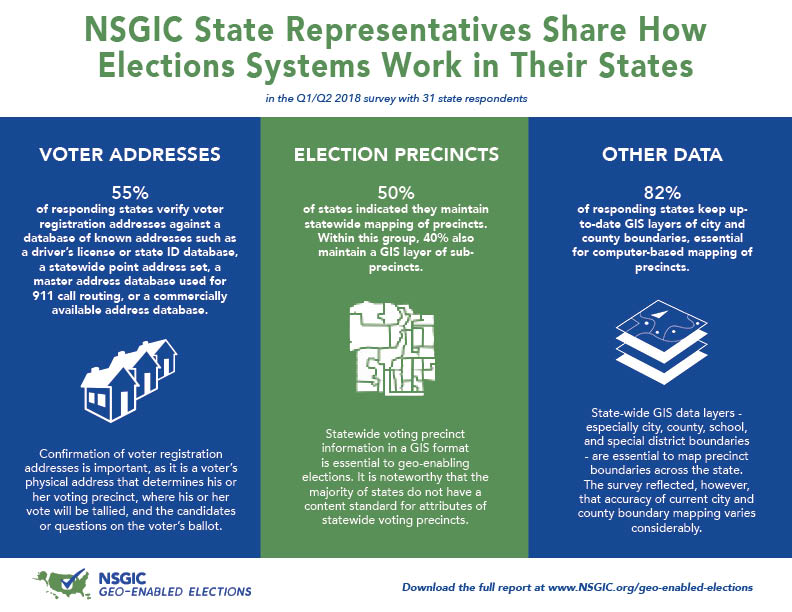
NSGIC State Representatives Share How Elections Systems Work in Their States
July 12, 2018

More than two-thirds of states responded to a nationwide survey on elections data conducted in the first half of 2018. Responses were coordinated by state government representatives who focus on the development and deployment of mapping data and systems across state agencies and local governments.
“An electoral system with integrity - enhanced by accurate, authoritative geographic data and presented clearly and transparently - has never been more important,” said NSGIC President Andy Rowan.
“Geo-enabled elections overcome the four fundamental challenges with the existing address list approach to precinct management,” said Rowan. “In the address list approach, no actual boundaries are stored explicitly in these systems; quality control is difficult without a method to visualize precinct assignment using aerial photography and boundary information that can change frequently; there is no efficient method for applying large-scale precinct boundary updates; and the process is usually not aligned efficiently with other state and local address or boundary management processes.”
Key takeaways from the survey include:
Addresses
55% of responding states confirm voter registration addresses against a database of known addresses such as a driver's license or state ID database, a statewide point address set, a master address database used for 9-1-1 call routing, or a commercially available address database.
“The results indicate a need to advocate for coordination between state agencies (e.g. state elections department and the department of motor vehicles) and encourage integration of the voting system and other systems,” says Jamie Chesser, the Geo-Enabled Elections project manager.
Election Precincts
More than half of responding states indicated they maintain statewide mapping of precincts. Within this group, 40% also maintain a layer of sub-precincts in digital mapping systems.
“There remains a need to develop local precinct data content and procedural standards to examine the relationship between precincts, local and state boundaries, and residential structures,” says Chesser.
Other Data
82% of states keep up-to-date spatial data of city and county boundaries, essential for computer-based mapping of precincts.
“Statewide spatial data - especially city, county, school, and special district boundaries - are essential to mapping precinct boundaries across the state,” says Chesser. “The survey reflected, however, that accuracy of current city and county boundary mapping varies considerably.”
A substantial majority, 79% of respondents, confirm their mapping of state-level district-based elected offices are accessible online in a digital mapping format.
The survey was conducted as part of NSGIC’s Geo-Enabled Elections project, which aims to provide the impetus for replacing non-spatial ‘address file’ tables with the visual and analytical advantages of election precinct and voter data in a natively geographic information systems format.
Later this year, NSGIC will release the results of a study probing the spatial approach to elections management from the perspective of state elections officials. The two-year Geo-Enabled Elections project, underwritten by the bipartisan Democracy Fund Voice, convenes a wide variety of stakeholders to explore ways geographic information systems and related processes can enhance elections management and citizen engagement across the US.
Download the full report here and learn more at nsgic.org/geo-enabled-elections.
Questions? Contact Geospatial Programs Manager Jamie Chesser [email protected]
|